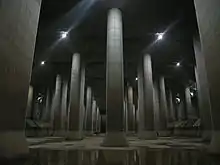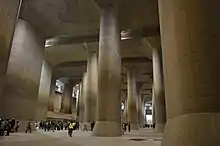Metropolitan Area Outer Underground Discharge Channel
The Metropolitan Area Outer Underground Discharge Channel (Japanese: 首都圏外郭放水路, Hepburn: shutoken gaikaku hōsuiro), is an underground water infrastructure project in Kasukabe, Saitama, Japan. It is the world's largest underground flood water diversion facility, built to mitigate overflowing of the city's major waterways and rivers during rain and typhoon seasons.[1] It is located between Showa in Tokyo and Kasukabe in Saitama prefecture, on the outskirts of the city of Tokyo in the Greater Tokyo Area, Japan.


Work on the project started in 1992 and was completed by early 2006.[2][3] It consists of five concrete containment silos with heights of 65 m and diameters of 32 m, connected by 6.4 km of tunnels, 50 m beneath the surface, as well as a large water tank with a height of 25.4 m, with a length of 177 m, with a width of 78 m, and with 59 massive pillars connected to 78 10 MW (13,000 hp) pumps that can pump up to 200 tons of water into the Edo River per second.[4]
.jpg.webp)
"Ryukyukan" for Underground Exploration Museum of The Metropolitan Area Outer Underground Discharge Channel is also a tourist attraction and can be visited for 3.000 Yen; however, the tours are conducted only in Japanese.[5]
Media coverage
The main water tank resembles a temple and has been used in some movies and TV programs to create mystic scenes. In 2006, a Land Rover television commercial and print campaign was produced using Metropolitan Area Outer Underground Discharge Channel as a location.
The Dutch TV program Wie is de Mol? had an assignment taking place in the water tank.
The video game Mirror's Edge featured several level designs inspired by the Metropolitan Area Outer Underground Discharge Channel.
In 2014, Australia's ABC TV science show Catalyst broadcast a short documentary (12'40") titled "Tokyo Flood Prevention" about this and associated flood mitigation structures. [6]
The 2015 movie The Hunger Games: Mockingjay – Part 2 also used the facility during the underground approach to the Capitol scenes.
See also
References
- "Metropolitan Area Outer Underground Discharge Channel". Archived from the original on September 14, 2018. Retrieved January 10, 2015.
- "CNN How giant tunnels protect Tokyo from flood threat".
- "G-Cans: Tokyo's Massive Underground Storm Drain".
- "G-Cans Project, Kasukabe, Saitama, Greater Tokyo Area, Japan". Retrieved 10 January 2015
- http://www.ktr.mlit.go.jp/edogawa/gaikaku/english/index.html
- "Catalyst: Tokyo Flood Prevention - ABC TV Science". ABC - Australian Broadcasting Corporation (Video Documentary). 2014-10-23. Retrieved 2015-03-20.
| Wikimedia Commons has media related to Metropolitan Area Outer Underground Discharge Channel. |
External links
- Official website (including photos) (in Japanese)